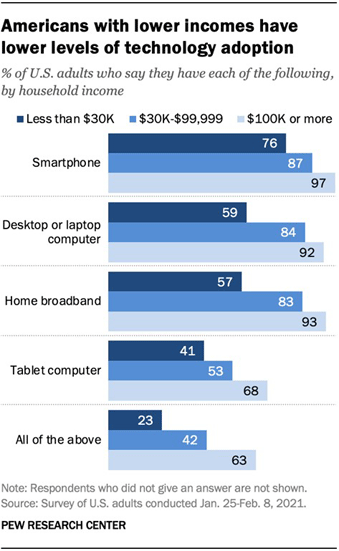A recent Pew survey found that while over 75% of Americans have a smartphone, there is a wide discrepancy between income levels for other devices that connect to the internet. This “Digital Divide” not only affects income levels but differences such as urban and rural areas. Having access is only a portion of the digital divide problem, digital literacy is needed to fully benefit from being connected. 
Libraries have been stepping up to this challenge for decades. The Colorado State Library released a report in 2002, Colorado Public Libraries & the “Digital Divide”, that looked at how public libraries were bridging the gap with public internet computers. It surveyed technology skills, age, race, education, and income levels. At that time, it reported “more than two-thirds of the library Internet patrons polled have no other access to the Internet except through public Internet computers.”
Job searches, job applications, online schooling, health resources, shopping, social interaction, and government services are all things the internet gives us access to. When the COVID-19 pandemic hit, this became more apparent and having access became crucial. Looking at the ability of school children to use online education, Colorado Futures Center found that 54,102 school-age children in Colorado were without internet. The report finds that “the children in households without internet are disproportionately Hispanic, younger, and from lower income households.” 57% have a parent working in an essential industry.
In 2012 Gov. Hickenlooper acknowledged that “broadband access is increasingly becoming a foundation for economic development, community engagement, and service delivery;” signing an executive order establishing broadband responsibilities in the Governors’ Office of Information Technology (OIT). During the COVID-19 pandemic, Gov. Polis recognized the further implications of needing broadband for healthcare, business, and schooling when there is necessary social distancing. He signed executive order B 2020 009, replacing Gov. Hickenlooper’s order, expanding the broadband responsibilities to include an advisory board that will coordinate with other State agencies.
Continuing their efforts under the governor’s direction, the Colorado Broadband Office (CBO), launched a new website this summer. It includes information for consumers, community organizers, and internet service providers. There you can find a Colorado broadband map, take a speed test, and report any areas that are without broadband service. On the funding page, you can sign up for a monthly newsletter for funding program highlights. Finally, to learn more about Broadband, the Digital Divide, and Digital Equity in Colorado, the CBO website has a Learning Center. Here you can learn more about device access and digital literacy in Colorado.
- Addressing Colorado’s Digital Divide - October 20, 2021
